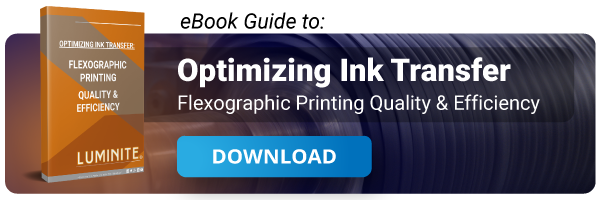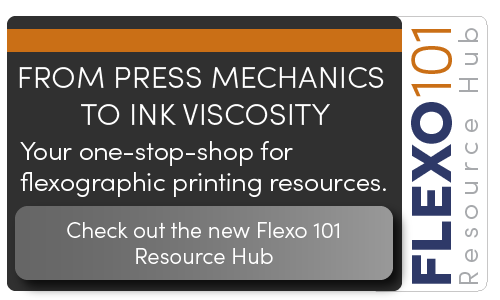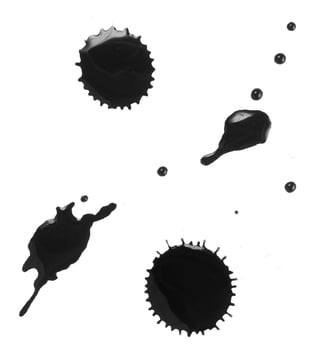
There’s a science behind your choice of ink. Different flexo printing inks are crafted to work best with varying image carriers and substrates.
There are a few considerations that go into this:
One of the most important of these is surface tension. Inks naturally want to flow to the higher dyne level. Proper surface tension configuration allows the most ink possible to be transferred to the substrate and ensures a full and even wet out.
Other considerations include:
- Chemical compatibility
- Final product usage
- Print speed requirements
- Regulatory compliance
- And others
Choice of substrate is also one of the main factors in ink selection.
Substrates can include:
- Corrugated board
- Paper
- Laminates
- Film
- Foils
4 Common Types of Flexographic Inks
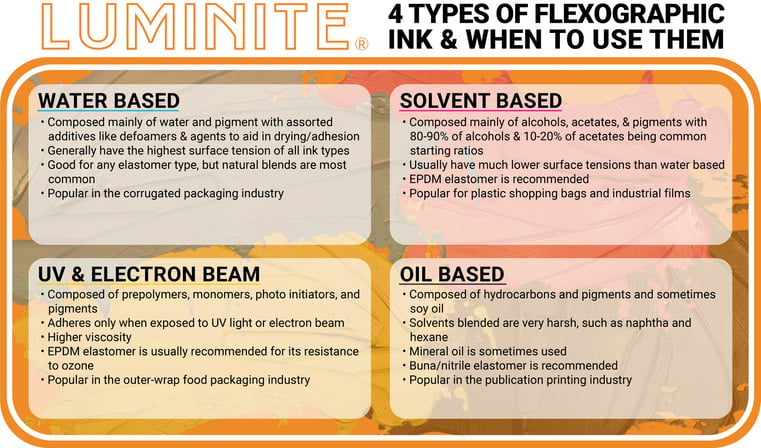
- Water based
- Solvent based
- Ultraviolet and electron beam
- Oil based
Here are some more details on these types of inks, and what applications they're best for:
1. Water Based
- Composed mainly of water and pigment with assorted additives like defoamers and agents to aid in drying and adhesion
- Generally have the highest surface tension of all ink types
- Good for any elastomer type, but natural blends are most common
- Popular in the corrugated packaging industry
2. Solvent Based
- Composed mainly of alcohols, acetates, and pigments with 80-90% of alcohols and 10-20% of acetates being common starting ratios
- Usually have much lower surface tensions than water-based
- EPDM elastomer is recommended
- Popular for plastic shopping bags and industrial films
3. Ultraviolet (UV) and Electron Beam (EB)
- Composed of prepolymers, monomers, photoinitiators, and pigments.
- Dries and adheres only when exposed to UV light or electron beam.
- Higher viscosity
- EPDM elastomer is usually recommended for its resistance to ozone
- Popular in the outer-wrap food packaging industry
Have questions on basic Flexographic topics? Check out our resource on sustainable printing: 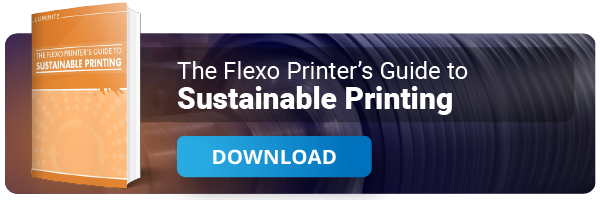
4. Oil Based
- Composed of hydrocarbons and pigments and sometimes soy oil
- Solvents blended are very harsh, such as naphtha and hexane
- Mineral oil is sometimes used
- Buna/nitrile elastomer is recommended
- Popular in the publication printing industry
Flexographic inks are separated into two classifications: volatile and energy curable.
- Volatile inks contain a liquid solvent -- like water or alcohol -- that evaporates and leaves the image on the substrate.
- Energy curable inks dry through intermolecular bonding, which solidifies the ink on the substrate.
Choosing Between Flexographic Inks
Any ink -- in the right formulas -- could work on nearly any substrate. But some physical combinations work better together, such as solvent based on plastic bags or oil based on newsprint.
Surface tension is a primary consideration in this choice. The ink should be the lowest dyne level. The printing surface of the plate or sleeve should be a higher dyne level, and the substrate the highest. Again, inks are drawn toward the higher surface energy.
ICYMI: We have a full guide to surface tension, and dyne level considerations for optimum printing.
Water-based inks typically face limitations on press speeds. However, solvent-based inks are known to dry in conventional ovens at high press speeds.
If the substrate is absorbent:
- Drying both water- and solvent-based inks is generally similar
- Water based is most commonly used
If the substrate is non-absorbent:
- Ability to dry the ink is critical
- Printers typically choose solvent-based, or UV curable inks
- Some water-based formulas do work
Good substrate and ink suppliers will work with printers to identify the best materials for a final products graphic, physical, and even chemical requirements. We can help in achieving the best possible setup with image carrier materials to match.
ARE YOU HAVING INK PROBLEMS DURING YOUR FLEXO PRINTING?
We have a free downloadable resource that covers ink viscosity and PH considerations, how to troubleshoot your ink transfer problems, what type of ink is best for your print applications, and more.
(Editors Note: This blog was originally produced in 2019 and was updated in August 2023 to reflect current and up-to-date information.)

